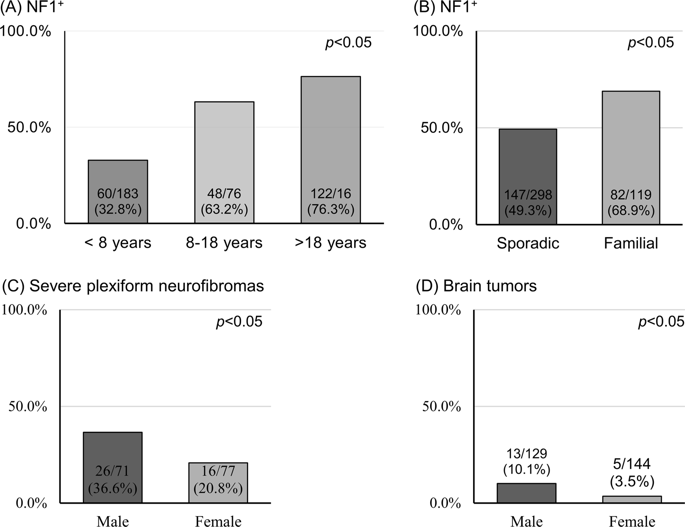当前位置:
X-MOL 学术
›
J. Hum. Genet.
›
论文详情
Our official English website, www.x-mol.net, welcomes your
feedback! (Note: you will need to create a separate account there.)
Phenotype categorization of neurofibromatosis type I and correlation to NF1 mutation types.
Journal of Human Genetics ( IF 2.6 ) Pub Date : 2019-11-28 , DOI: 10.1038/s10038-019-0695-0 Eungu Kang 1 , Yoon-Myung Kim 2 , Go Hun Seo 3 , Arum Oh 3 , Hee Mang Yoon 4 , Young-Shin Ra 5 , Eun Key Kim 6 , Heyry Kim 3 , Sun-Hee Heo 7 , Gu-Hwan Kim 8 , Mark J Osborn 9 , Jakub Tolar 9 , Han-Wook Yoo 3, 8 , Beom Hee Lee 3, 8
Journal of Human Genetics ( IF 2.6 ) Pub Date : 2019-11-28 , DOI: 10.1038/s10038-019-0695-0 Eungu Kang 1 , Yoon-Myung Kim 2 , Go Hun Seo 3 , Arum Oh 3 , Hee Mang Yoon 4 , Young-Shin Ra 5 , Eun Key Kim 6 , Heyry Kim 3 , Sun-Hee Heo 7 , Gu-Hwan Kim 8 , Mark J Osborn 9 , Jakub Tolar 9 , Han-Wook Yoo 3, 8 , Beom Hee Lee 3, 8
Affiliation

|
Neurofibromatosis type 1 (NF1) is caused by heterozygous mutation in the NF1 gene. NF1 is one of the most common human genetic diseases. However, the overall genotype-phenotype correlation has not been known, due to a wide spectrum of genotypic and phenotypic heterogeneity. Here we describe the detailed clinical and genetic features of 427 Korean NF1 patients from 389 unrelated families. Long range PCR and sequencing of genomic DNA with multiplex ligation-dependent probe amplification analysis identified 250 different NF1 mutations in 363 families (93%), including 94 novel mutations. With an emphasis on phenotypes requiring medical attention (classified and termed: NF1+), we investigated the correlation of NF1+ and mutation types. NF1+ was more prevalent in patients with truncating/splicing mutations and large deletions than in those with missense mutations (59.6%, 64.3% vs. 36.6%, p = 0.001). This difference was especially significant in the patients younger than age 19 years. The number of items in NF1+ was a higher in the former groups (0.95 ± 0.06, 1.18 ± 0.20 vs. 0.56 ± 0.10, p = 0.002). These results suggest that mutation types are associated not only with higher prevalence of severe phenotypes in NF1 but also with their earlier onset.
中文翻译:

I型神经纤维瘤病的表型分类及其与NF1突变类型的相关性。
1型神经纤维瘤病(NF1)是由NF1基因的杂合突变引起的。NF1是人类最常见的遗传疾病之一。然而,由于广泛的基因型和表型异质性,总体基因型与表型的相关性尚不清楚。在这里,我们描述了来自389个无关家庭的427名韩国NF1患者的详细临床和遗传学特征。远程PCR和基因组DNA的测序以及多重连接依赖性探针扩增分析确定了363个家族(93%)中的250个不同NF1突变,其中包括94个新突变。为了强调需要医疗照顾的表型(分类并称为:NF1 +),我们研究了NF1 +与突变类型的相关性。截短/剪接突变和大缺失的患者中NF1 +的比例高于错义突变的患者(59.6%,64.3%vs. 36.6%,p = 0.001)。在19岁以下的患者中,这种差异尤为明显。在前一组中,NF1 +中的项目数更高(0.95±0.06、1.18±0.20和0.56±0.10,p = 0.002)。这些结果表明,突变类型不仅与NF1中严重表型的较高患病率有关,而且还与它们的较早发作有关。
更新日期:2019-11-28
中文翻译:

I型神经纤维瘤病的表型分类及其与NF1突变类型的相关性。
1型神经纤维瘤病(NF1)是由NF1基因的杂合突变引起的。NF1是人类最常见的遗传疾病之一。然而,由于广泛的基因型和表型异质性,总体基因型与表型的相关性尚不清楚。在这里,我们描述了来自389个无关家庭的427名韩国NF1患者的详细临床和遗传学特征。远程PCR和基因组DNA的测序以及多重连接依赖性探针扩增分析确定了363个家族(93%)中的250个不同NF1突变,其中包括94个新突变。为了强调需要医疗照顾的表型(分类并称为:NF1 +),我们研究了NF1 +与突变类型的相关性。截短/剪接突变和大缺失的患者中NF1 +的比例高于错义突变的患者(59.6%,64.3%vs. 36.6%,p = 0.001)。在19岁以下的患者中,这种差异尤为明显。在前一组中,NF1 +中的项目数更高(0.95±0.06、1.18±0.20和0.56±0.10,p = 0.002)。这些结果表明,突变类型不仅与NF1中严重表型的较高患病率有关,而且还与它们的较早发作有关。











































 京公网安备 11010802027423号
京公网安备 11010802027423号